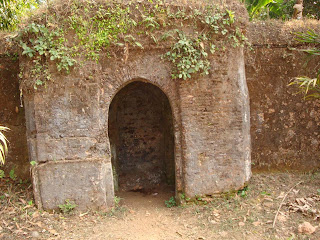The remains of the palace of the Jaintia monarchs stand beside the main road from Sylhet to Jaflong, and the ominously named Zero Point on the border between Bangladesh and the Indian State of Meghalaya.
About 40km north of Sylhet, the palace is believed to have been built by King Lakshmi Sinha in the late 17th Century, when his realm took in most of present day Sylhet.
The Jaintia peoples are part of the same indigenous group as the rather better know Khasia people, who still occupy ground in the Khasia Hills that border Assam. This border, arbitrarily drawn by a British bureaucrat for the 1947 partition of India, truncated, in its passage down the eastern border of Bangladesh, the traditional territories of dozens of Indigenous people of Central Asian heritage.
The fortunes of the Jaintia/Khasia ebbed and flowed over the many centuries of their occupation of the lands, that certainly predated the first of the Muslim invaders from Afghanistan, until their entire territory, after invasion and occupation from every direction, was finally annexed by the British in 1935.
The most obvious feature in the centre of what remains of the palace, with it’s very evidently Mughal influenced architecture, is a large, keyhole shaped platform with a deep groove etched down it. This, is widely believed, was the sacrificial platform, and judging by its size, it wasn’t for sacrificing chicken or goats. Tradition has it that the Jaintia, like the Kasi, were certainly animists until the Christian missionaries of the late 19th Century arrived. A belief tradition that still lingers amongst some Kasi, and other indigenous peoples of the hills. The Jaintia apparently regarded a snake as the object of their veneration, and adversity suggested to them that propitiation was required, which needed blood. It is said that human sacrifice was part of that tradition.
Outside the main gate is a platform of unusually large, flat stones where the monarch held court. Rare Megaliths stand both by that platform, and one a little north of the town, across the river, where more platform stones enabled court to be held north of the river. Such megaliths have been found nowhere else in Bangladesh, and are rare across the subcontinent, though interestingly, perhaps coincidentally, similar megaliths are common in North and North West Europe.
Sadly, those norths of the river are easy to miss in the confusion of the tyre repair business that has spread across the theoretically protected ground.
Perhaps one of the more interesting palace ruins in Bangladesh, Jaintiapur palace, and the many shrines and temples in the area are certainly worth time spend.






Good to find some information about the winter capital of the Kingdom of Jaintia. It'd be great to see some more photos of the megalithic structures if you have them.
ReplyDelete